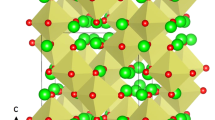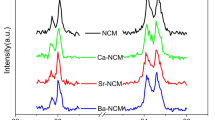Abstract
The development of new cathode materials with high capacity, good stability, and high safety is important for the future improvement of Li batteries. LiFeBO3 is considered to be a type of promising electrode materials for Li-ion batteries due to its low cost, high theoretical capacity of 220 mAh/g (about 30% larger than that of LiFePO4), low toxicity, and small volume change of 2% during the Li+ reversible extraction/insertion process. However, its electronic conductivity and rate performance still need further improvement. To optimize the performance of the LiFeBO3, Mn, Cr, and Ni doping at Fe site have been studied experimentally, while the effect of minor addition of 3d transition metals on the electronic structure of LiFeBO3 is rarely investigated. Thus, density functional theory calculations corrected by on-site Coulomb interactions have been conducted to study the crystal structure and electronic property of the LiFe1−xMxBO3 (M = Mn, Co, and Ni) electrode systems. The results indicate that the coordination geometry about Fe in LiFeBO3 is a distorted trigonal bipyramid with a distortion which can be attributed to a Jahn-Teller effect. The band gap energy of LiFeBO3 is calculated to be 3.40 eV, which is in reasonable agreement with the previously computed values. The doping at Fe site with Mn cannot reduce the distortion of Jahn-Teller effect, whereas Co doping intensifies Jahn-Teller distortion of the FeO5 trigonal bipyramid in LiFeBO3. Ni substitution is predicted to be able to introduce impurity levels, and the Jahn-Teller distortion degree of the trigonal bipyramid decreased from 11.9 of the FeO5 to 8.7% of the NiO5. Thus, Ni doping is expected to increase stability and the electronic conductivity of the LiFeBO3 structure.





Similar content being viewed by others
Change history
13 November 2020
A Correction to this paper has been published: <ExternalRef><RefSource>https://doi.org/10.1007/s10008-020-04869-8</RefSource><RefTarget Address="10.1007/s10008-020-04869-8" TargetType="DOI"/></ExternalRef>
References
Ghorbanzadeh M, Allahyari E, Riahifar R, Hadavi SMM (2017) Effect of Al and Zr co-doping on electrochemical performance of cathode Li[Li0.2Ni0.13Co0.13Mn0.54]O2 for Li-ion battery. J Solid State Electrochem 22:1155–1163
Padhi AK, Nanjundaswamy KS, Masquelier C (1997) Effect of structure on the Fe3+/Fe2+ redox couple in iron phosphates. J Electrochem Soc 144(5):1609–1613
Hu S, Wang C, Zhou L, Zeng X, Shao L, Zhou J, Zhou C, Huang C, Xi X, Yang L (2018) Hydrothermal-assisted synthesis of surface aluminum-doped LiCoO2, nanobricks for high-rate lithium-ion batteries. Ceram Int 44(13):14995–15000
Yu S, Hu J, Hussain MB, Wu S, Yang Y, Zhu Z (2018) Structural stabilities and electrochemistry of Na2FeSiO4 polymorphs: first-principles calculations. J Solid State Electrochem 22(7):2237–2245
Yamada A, Chung SC, Hinokuma K (2001) Optimized LiFePO4 for lithium battery cathodes. J Electrochem Soc 3(148):A224–A229
Prosini PP, Lisi M, Zane D, Pasquali M (2002) Determination of the chemical diffusion coefficient of lithium in LiFePO4. Solid State Ionics 148(1–2):45–51
Meng YS, Arroyo-De Dompablo ME (2011) Recent advances in first principles computational research of cathode materials for lithium-ion batteries. Acc Chem Res 46:1171–1180
Cai Y, Chen G, Xu X, Du F, Zhe L, Meng X, Wang C, Wei Y (2011) First-principles calculations on the LiMSO4F/MSO4F (M = Fe, Co, and Ni) systems. J Phys Chem C 115(14):7032–7037
Tao L, Neilson JR, Melot BC, McQueen TM, Masquelier C, Rousse G (2013) Magnetic structures of LiMBO3 (M = Mn, Fe, Co) lithiated transition metal borates. Inorg Chem 52(20):11966–11974
Yamada A, Iwane N, Harada Y, Nishimura SI, Koyama Y, Tanaka I (2010) Lithium iron borates as high-capacity battery electrodes. Adv Mater 22(32):3583–3587
Legagneur V, An Y, Mosbah A, Portal R, Salle ALGL, Verbaere A, Guyomard D, Piffard Y (2001) LiMBO3 (M = Mn, Fe, Co): synthesis, crystal structure and lithium deinsertion/insertion properties. Solid State Ionics 139(1–2):37–46
Janssen Y, Middlemiss DS, Bo SH, Grey CP, Khalifah PG (2012) Structural modulation in the high capacity battery cathode material LiFeBO3. J Am Chem Soc 134(30):12516–12527
Chen Z, Cao L, Chen L, Zhou H, Zheng C, Xie K, Kuang Y (2015) Mesoporous LiFeBO3/C hollow spheres for improved stability lithium-ion battery cathodes. J Power Sources 298:355–362
Yamada A, Iwane N, Nishimura SI, Koyama Y, Tanaka I (2011) Synthesis and electrochemistry of monoclinic Li(MnxFe1-x)BO3: a combined experimental and computational study. J Mater Chem 21(29):10690–10696
Dong X, Huang C, Jin Q, Zhou J, Feng P, Shi Y, Zhang D (2017) Enhancing the rate performance of spherical LiFeBO3/C via Cr doping. RSC Adv 7(54):33745–33750
Zhang B, Ming L, Tong H, Zhang J, Zheng J, Wang X, Li H, Cheng L (2018) Ni-doping to improve the performance of LiFeBO3/C cathode material for lithium-ion batteries. J Alloys Compd 740:382–388
Exner KS (2018) A short perspective of modeling electrode materials in lithium-ion batteries by the ab initio atomistic thermodynamics approach. J Solid State Electrochem 22(10):3111–3117
Leiva EPM (2020) Modeling of lithium-ion batteries is becoming viral: where to go? J Solid State Electrochem 24(9):2117–2120
Nayak D, Sarkar T, Chaudhary NVP, Bharadwaj MD, Ghosh S, Adyam V (2017) Electrochemical properties and first-principle analysis of Nax[MyMn1−y]O2 (M = Fe, Ni) cathode. J Solid State Electrochem 22:1079–1089
Mattsson AE, Schultz PA, Desjarlais MP, Mattsson TR, Leung K (2005) Designing meaningful density functional theory calculations in materials science a primer. Model Numer Simul Mater Sci 13(1):R1–R31
Huang Z, Meng X, Wang CZ, Sun W, Chen G (2006) First-principles calculations on the Jahn-Teller distortion in layered LiMnO2. J Power Sources 158(2):1394–1400
Prasad R, Benedek R, Kropf AJ, Johnson CS, Robertson AD, Bruce PG, Thackeray MM (2003) Divalent-dopant criterion for the suppression of Jahn-Teller distortion in Mn oxides: first-principles calculations and x-ray absorption spectroscopy measurements for Co in LiMnO2. Phys Rev B 68(1):012101
Perdew JP, Burke K, Ernzerhof M (1996) Generalized gradient approximation made simple. Phys Rev Lett 77(18):3865–3868
Kresse G (1996) Efficient iterative schemes for ab initio total-energy calculations using a plane-wave basis set. Phys Rev B 54(16):11169–11186
Xu Z, Rossmeisl J, Kitchin JR (2015) A linear response, DFT + U study of trends in the oxygen evolution activity of transition metal rutile dioxides. J Phys Chem C 119(9):4827–4833
Zhou F, Cococcioni M, Kang K, Ceder G (2004) The Li intercalation potential of LiMPO4 and LiMSiO4 olivines with M = Fe, Mn, Co, Ni. Electrochem Commun 6(11):1144–1148
Seo DH, Park YU, Kim SW, Park I, Shakoor RA, Kang K (2011) First-principles study on lithium metal borate cathodes for lithium rechargeable batteries. Phys Rev B 83(20):205127
Lv X, Xu Z, Li J, Chen J, Liu Q (2016) Insights into stability, electronic properties, defect properties and Li ions migration of Na, Mg and Al-doped LiVPO4F for cathode materials of lithium ion batteries: a first-principles investigation. J Solid State Chem 239:228–236
Jiang F, Di Y, Liu E, Chen S, Chen F, Zhu X, Wang X, Lu Z (2020) First-principles investigation of the structural stability and electronic properties of LiV1–xMxPO4F (M = Mn, Fe, Co, and Ni). J Solid State Electrochem 24(4):1075–1084
Mishra SK, Ceder G (1999) Structural stability of lithium manganese oxides. Phys Rev B 59(9):6120–6130
Smith AE, Mizoguchi H, Delaney K, Spaldin NA, Sleight AW, Subramanian MA (2009) Mn3+ in trigonal bipyramidal coordination: a new blue chromophore. J Am Chem Soc 131(47):17084–17086
Kalantarian MM, Asgari S, Mustarelli P (2014) A theoretical approach to evaluate the rate capability of Li-ion battery cathode materials. J Mater Chem A 2(1):107–115
Kalantarian MM, Hafizi-Barjini M, Momeni M (2020) Ab initio study of AMBO3 (A = Li, Na and M = Mn, Fe, Co, Ni) as cathode materials for Li-ion and Na-ion batteries. ACS Omega 5(15):8952–8961
Oliver DJ (1962) Electrical properties of n-type gallium arsenide. Phys Rev 127(4):1045–1052
Svavarsson HG, Gudmundsson JT, Gislason HP (2003) Impurity band in lithium-diffused and annealed GaAs: conductivity and hall effect measurements. Phys Rev B 67(20):205213
Exner KS (2017) Constrained ab initio thermodynamics: transferring the concept of surface pourbaix diagrams in electrocatalysis to electrode materials in lithium-ion batteries. ChemElectroChem 4:1–8
Funding
This work was supported by the Open Research Subject of Powder Metallurgy Engineering Technology Research Center of Sichuan Province, China (grant nos. SC-FMYJ2017-03, SC-FMYJ2018-02).
Author information
Authors and Affiliations
Corresponding authors
Ethics declarations
Conflict of interest
The authors declare that they have no conflict of interest.
Additional information
Publisher’s note
Springer Nature remains neutral with regard to jurisdictional claims in published maps and institutional affiliations.
The original online version of this article was revised: One of the author should be named as "Haonan Zhang" rather than "Haonang Zhang”
Rights and permissions
About this article
Cite this article
Jiang, F., Chen, S., Zhang, H. et al. First-principles study on the Jahn-Teller distortion in trigonal bipyramidal coordinated LiFe1−xMxBO3 (M = Mn, Co, and Ni) compounds. J Solid State Electrochem 25, 627–635 (2021). https://doi.org/10.1007/s10008-020-04836-3
Received:
Revised:
Accepted:
Published:
Issue Date:
DOI: https://doi.org/10.1007/s10008-020-04836-3




